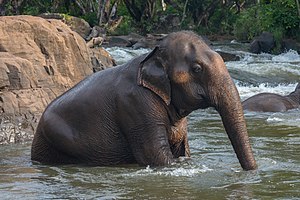Elephant

Elephants are the largest land animals in existence. Currently, three living species are recognized: the African bush elephant, the African forest elephant, and the Asian elephant. They are the only surviving members of the Elephantidae family and the Proboscidea order. In the past, the order had much greater diversity during the Pleistocene, but most species became extinct in the Late Pleistocene epoch.
Elephants possess distinctive features such as a long proboscis called a trunk, tusks, large ear flaps, pillar-like legs, and tough but sensitive skin. The trunk is a versatile tool used for breathing, bringing food and water to the mouth, and grasping objects. Tusks, derived from the incisor teeth, serve as both weapons and tools for moving objects and digging. The large ear flaps help regulate body temperature and aid in communication. African elephants have larger ears and concave backs, while Asian elephants have smaller ears and convex or level backs.
Elephants are found across sub-Saharan Africa, South Asia, and Southeast Asia, inhabiting various habitats including savannahs, forests, deserts, and marshes. They are herbivorous and tend to stay near accessible water sources. Considered keystone species, elephants have a significant impact on their environments. They have a fission-fusion society, where multiple family groups come together to socialize. Female elephants (cows) typically live in family groups, which can consist of a single female with her calves or multiple related females with offspring. These groups, led by the oldest female known as the matriarch, do not include males (bulls).
Male elephants (bulls) leave their family groups upon reaching puberty and may live alone or with other males. Adult bulls primarily interact with family groups when seeking a mate. During this time, they undergo a period of increased testosterone and aggression called musth, which helps them establish dominance over other males and achieve reproductive success. Calves are the focal point within their family groups and rely on their mothers for up to three years. In the wild, elephants can live up to 70 years. They communicate through touch, sight, smell, and sound, utilizing infrasound and seismic communication over long distances. Elephant intelligence has been compared to that of primates and cetaceans. They display self-awareness and exhibit empathy towards dying and deceased family members.
The African bush elephant and Asian elephant are listed as endangered, while the African forest elephant is classified as Critically Endangered by the International Union for Conservation of Nature (IUCN). The ivory trade poses one of the most significant threats to elephant populations, as these animals are poached for their tusks. Other threats include habitat destruction and conflicts with local communities. Elephants are also used as working animals in Asia. In the past, they were employed in warfare.
In a nutshell
- Elephants are the largest living land mammals on the planet, that habitat sub-Sharan Africa, South Asia, and Southeast Asia.
- There are three different species of elephant: African Savannah (Bush), African Forest and Asian. You can tell them apart by their ears and their trunks.
- Elephants have large ears that help them regulate their body temperature. They also have long trunks that they use for various purposes, such as picking up objects, trumpeting warnings, greeting other elephants, or sucking up water.
- Elephant tusks are actually enlarged incisor teeth that grow throughout their lives. They use them for feeding, digging, or fighting. Both male and female African elephants grow tusks, but only male Asian elephants do.
- Elephants eat up to 150 kg of food per day, mostly grasses, leaves, fruits and roots. They can spend up to 18 hours a day eating. They also create a lot of poo, which fertilizes the soil and disperses seeds.
- Elephants have a very long gestation period of 22 months, the longest of any animal. They give birth to calves that weigh up to 120 kg and can stand up shortly after being born.
- Elephants are very social animals that live in family groups led by a matriarch. They communicate with each other through sounds, body language, touch and vibrations. They can also show emotions like joy, grief and empathy.
- Elephants are very intelligent and have large brains. They can remember places, people and other elephants for a long time. They can also use tools, cooperate, and learn new skills.
- Elephants are endangered due to habitat loss, human-elephant conflict and poaching for their ivory. There are more African elephants than Asian elephants, but both species need protection and conservation efforts.
- Elephants have some amazing adaptations that help them survive in their environments. For example, they can create their own sunscreen by throwing mud and sand over themselves, or use their tusks to mine for salt in underground caves.
| This page forms part of Project Species and considered an phase 2 article (started but not complete). Please consider adding more knowledge to this page. See Project Species for more information. |
See also
- The effects of captivity on elephants
- Elephant tourism
- List of living captive elephants
- List of captive elephant deaths
- Bullhooks
- Phajaan
- Elephant Portal
- Elephant (interviews)
- Elephant (news)
- Elephant (research)
- Elephant (videos)
External links
- Elephant Wikipedia
- Elephas maximus Wikispecies
